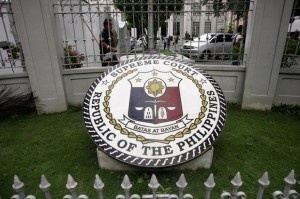SC: No need for direct evidence to sack corrupt judges
MANILA, Philippines—Magistrates beware: it doesn’t take direct evidence of bribery to get you fired.
An internal purge initiated as part of the reform efforts when Chief Justice Ma. Lourdes Sereno took over the helm at the Supreme Court in August 2012 has led to the dismissal of 13 judges and justices, reflecting Sereno’s strong stance against undesirables in the ranks.
Raul Villanueva, the deputy court administrator, said this on Wednesday in a lecture on the Sereno court’s judicial reforms at the opening of a three-day international summit on judicial integrity and accountability in Makati.
The conference, organized by the Center for International Law and Konrad Adenauer Stiftung-Asia, brought together 50 lawyers, court officials and private sector representatives from Southeast Asia for discussions on judicial independence, integrity and transparency.
Judicial conduct violated
In his presentation, Villanueva cited the dismissal of two officers of the court this year, where the court voted for dismissal even without direct proof that those under investigation had accepted bribes. Evidence of offensive conduct was enough for the court, he said.
“…[T]he SC is no longer looking for direct evidence of corruption in order to dismiss a justice. So long as there is direct evidence that canons of judicial conduct had been violated, the likelihood of dismissal is already there,” said Villanueva.
Pleas for reconsideration are unlikely to be given weight once the high court decides on firing a judge or justice, he added.
The official did not identify the dismissed magistrates, but one such case was the sacking of Sandiganbayan Associate Justice Gregory Ong in September for his “corrupt inclinations,” as shown by his links with businesswoman Janet Lim-Napoles, the alleged brains behind the P10-billion pork barrel scam.
In a majority ruling, the court found Ong guilty of grave misconduct, dishonesty and impropriety for “fraternizing” with Napoles, who was among the accused in a malversation case over the allegedly irregular delivery of P3.8 million worth of substandard Kevlar helmets to the Marines in 1998. The division in the antigraft court that Ong headed had acquitted Napoles in the case.
The court noted that no direct evidence of bribery was found during the investigation, despite allegations by pork barrel scam whistle-blower Benhur Luy that Ong had accepted checks from Napoles amounting to P3.1 million.
Another case involved a trial court judge who was accused of partiality, incompetence, gross misconduct, gross ignorance of the law and conduct unbecoming of a judge.
A litigant, a flight attendant, had complained that the judge had met him and allegedly “asked inappropriate questions.”
Reversed findings
While the Court of Appeals recommended against penalizing the judge, the high court completely reversed the appellate court’s findings and ordered the magistrate’s dismissal from service in June this year, more than three years since the complaint was filed.
The Court of Appeals handles disciplinary cases against trial court judges.
Villanueva said such decisions showed the Supreme Court’s stern stance against corruption and misconduct.
“I don’t want to predict whether there is a pattern,” Villanueva replied, when asked whether there was an apparent uptrend in dismissals.
“At least they are acting on these cases, as part of reforms under [Sereno]… Usually they adopt [the recommendations of the Court of Appeals]. But in the case I mentioned (the complaint against the judge), they reversed the decision completely. You see that they (Supreme Court justices) are really serious,” he said.
Apart from the dismissals, the high court admonished seven magistrates, reprimanded 3, issued stern warnings against 23, fined 34 and suspended 6.
RELATED STORIES
Expose corrupt judges, Sereno urges lawyers
